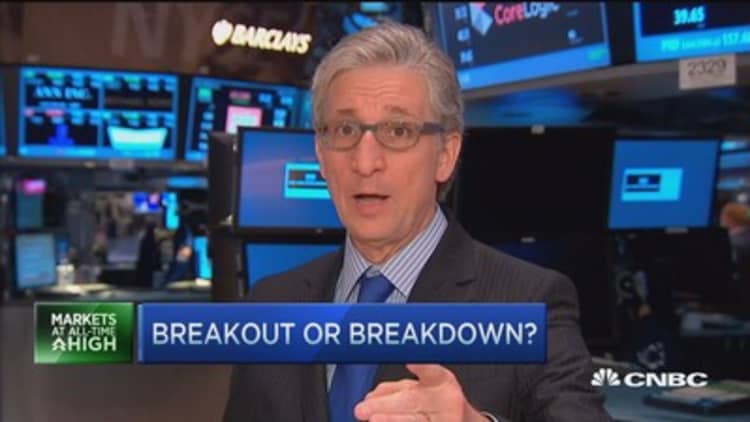
Stocks have entered what could be viewed as a "twilight zone," marked by volatility, "flash crashes" and just moderate returns until the economy improves enough for the Fed to hike rates, according to Bank of America Merrill Lynch strategists.
They remain bullish on stocks, but expect a rocky period where investors are trapped in a transition period while the markets sort out whether the coast is clear for the central bank to proceed on rate increases. There is also a risk the market could react to the prospect of rate hikes with a violent selloff.
BofA Merrill Lynch's chief investment strategist, Michael Hartnett, said there's even the potential the market will behave the way it did in 1987 and 1998, "where you've got basically a very sharp midcycle correction rather than the onset of a bear market."
"It certainly can't be dismissed," Hartnett said, noting there are "quite vicious price movements in foreign exchange, fixed income and commodities. I don't think equities should be an exception."
Read MoreThe two stocks that could help the Dow reach 20,000
Stocks have been bumping up against record highs, with the Dow and S&P 500 setting new intraday highs Monday. But a batch of weak economic data has raised concerns recently that the economy and earnings could falter. That has also generated speculation the Fed will have to hold off on a rate hike, extending its stay at zero rates—a positive for stocks—until next year.
Read MoreNo Fed rate hike this year—Cashin
Hartnett said the era of maximum liquidity and high returns is at least temporarily over. The strategists recommend a mid-2015 strategy where investors sell risk assets into strength, while adding gold, buying volatility into weakness and holding higher-than-normal cash levels,
"We've had really good liquidity and really good profits, and that's the dream combination. What the market wants to believe is that while there's less liquidity, the profits are still around. It's less good, but it ain't bad," Hartnett said.
While the recent move up in interest rates is one possible warning for stocks, Hartnett said a jump in short-end rates could be a sign of trouble for stocks as it would prompt investors to move into cash. Another warning would be if bank stocks declined with higher rates instead of rising as they are now, a sign of health.
Read MoreCNBC Strategist Survey: Year end targets
Hartnett said some unexpected, innocuous factor or data point could trigger a selloff. "It's often when there are very crowded positions that can get unwound," he said, pointing to the Chinese stock market and European debt.
"Just generally in the U.S., it would be high P/E, high dividend yielding (stocks) and high-yield debt assets," he said.
BofA Merrill Lynch has an S&P 500 target of 2,200 for year-end 2015, which is based on an EPS forecast of $117.50.
Read MoreDo you know what's in your portfolio?
The BofA Merrill Lynch analysts are not alone in looking for a correction, related to the Fed rate hike cycle.
Deutsche Bank's chief U.S. equity strategist, David Bianco, said the recent weak economic reports and Fed expectations could cause choppy seas for stocks.
"I'm expecting a 7 to 10 percent pullback in the (stock) market. I think that's what we're heading for this summer," said Bianco. "An even-worse scenario would be if the labor market rolls over too. Nobody believes we're looking at a full-blown nasty recession but we could have a growth stall, for sure."
In their note, the BofA Merrill Lynch strategists said ever since the Fed tapered investors have been "scarred by a series of vicious 'pain trades,' crowded trades suffering harmful reversals."
Those include the sudden and painful peak in the dollar, related to weak first-quarter data, which they say caused the central bank "to blink in March." They also point to the biotech selloff and the trough in oil prices.
There was also the "priced-to-perfection" move in German bunds and other European sovereign debt this year. That was disrupted in part by a surprise turn higher in European inflation, and even Spain outperformed U.S. first-quarter growth.
"A sudden 'buyers strike' for $6 tn of negatively-yielding global government bonds (it's now $4.5 tn) caused a 16 percent crash in German bund futures in 13 trading days," the strategists wrote.


